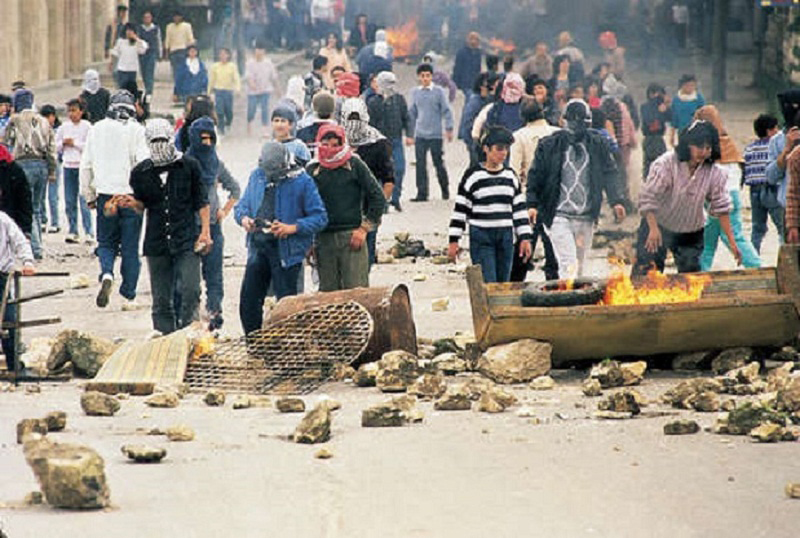SUNDAY December 8th, marked the 37th anniversary of the First Intifada, the great Palestinian uprising that redefined resistance against the Israeli occupation and apartheid.
Intifada is an Arabic word for an uprising or rebellion, literally meaning ‘tremor’ or ‘shuddering’ as a noun. It is derived from the Arabic term nafada, meaning ‘shaking off’ or ‘getting rid of’.
The term entered the revolutionary and political vocabulary in 1987 when Palestinians rose en masse against the Zionist occupation after four Palestinian labourers were mowed down and killed by an Israeli military vehicle in the northern Gaza Strip.
The First Intifada, which later came to be known as the ‘Stone Intifada’, took place in the fortieth year after the founding of the Zionist entity and changed the dynamics of engagement between the oppressor and the oppressed.
Before the First Intifada, Palestinian struggles were mainly carried out in the form of various leftist and non-religious political organisations, all of which used the same tactic of placing the gravity of the struggles outside or adjacent to the occupied territories.
The great uprising in December 1987 was strongly influenced by newly founded Islamic movements that advocated general, united, and comprehensive resistance to the occupier on their soil.
What were the causes of First Intifada?
The causes of the First Intifada are multifaceted, including the prolonged occupation and humiliation faced by Palestinians, the regional political turmoil of the time, and other related incidents.
The main reason, however, was the humiliation faced by Palestinians as second-class citizens in the occupied territories and continued land grabs by Jewish settlers coming from different countries.
The Palestinian people were frustrated by the policies of both their neighbours and their former main allies toward the Israeli regime, with the abandonment of armed struggle, the recognition of United Nations resolutions, and their joining the reconciliation process with the occupation regime.
The peak of this retreat can be seen in the Amman summit, where the leaders of Arab countries, by turning their backs on the main motive and goal of forming the Arab League, viewed the Palestinian question as a secondary issue.
The Palestinian Intifada therefore began in a situation where those involved in the Palestinian issue believed that the only way forward for the Palestinians was through compromise and concessions.
On the other hand, the victory of the 1979 Islamic Revolution of Iran influenced the formation of the Intifada in two ways: by providing a model of struggle, i.e. bringing the people into the battlefield, as well as by influencing the decisions of the Arabs in the region.
Inspired by the Iranian people, Palestinians took to the field in a way that suited their political, economic and social conditions, and took the struggle out of the framework of Arab political equations.
How did the First Intifada unfold?
The Intifada began on December 8th, 1987, in the Jabalia refugee camp in the northern Gaza Strip, after an Israeli truck driver killed four Palestinian workers, including three from the refugee camp.
The attack was carried out in order to avenge the death of the Israeli commander of the military police in an ambush by the Palestinian Islamic Jihad movement on a Zionist patrol group days earlier.
In this operation, four Palestinian fighters, Muhammad Saeed Jamal, Sami Sheikh Khalil, Ahmad Halas and Zuhdi Qurtaba, were martyred.
The vehicle-ramming attack by the Israeli driver was public and brutal, killing four defenceless Palestinian Muslim workers under the wheels of the truck, and seriously injuring nine others.
Following this incident, the situation across the occupied territories became inflamed, and Palestinian men and women took to the streets en masse, forming the core of the Intifada.
The Palestinian response was characterised by protests, civil disobedience, barricading and widespread throwing of stones and Molotov cocktails at the Israeli army and its infrastructure within the West Bank and Gaza Strip.
The uprising continued for the next six years, during which the Tel Aviv regime used disproportionate force, resulting in the killing of nearly 2,000 Palestinians.
The First Intifada was so costly for the occupiers that Yitzhak Rabin, the then Prime Minister of the Zionist regime, said: ‘I wish that one day I would wake up and see all of Gaza submerged in the sea and that I would be free from the evil of this region.’
What were the consequences of theFirst Intifada?
The Intifada was able to create several fundamental axes in the developments in Palestine, including directing the field of struggle against the occupiers back into the occupied territories after many years.
Before the major uprising, the fate of the Palestinian people was being determined in diplomatic negotiations behind closed doors by Arab and Western diplomats outside the occupied territories.
The December 1987 Intifada caused the Palestinian side to be placed in a position where it no longer had the status of the defeated party, but in many cases imposed certain conditions on its enemy.
The Intifada caused the Zionists to take a defensive position and give concessions to the Palestine Liberation Organisation (PLO) in order to quell the popular uprising.
A major political victory for the Palestinians was the declaration of an independent state, announced a year after the outbreak of the Intifada, recognised by most of the world’s countries to this day.
The First Intifada also inspired Palestinian resistance movements to continue their struggle against occupation and oppression, and garnered great international interest in their struggle.
